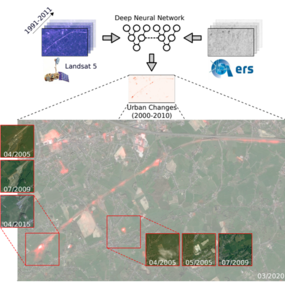More than half of the Earth's population already lives in urban areas, and they are growing faster than ever before. Researchers at IT4Innovations, in collaboration with the University of Leeds in the UK, have trained a neural network to recognise how cities are changing over the decades, using remote sensing data from the European Space Agency (ESA). The aim of this collaboration is to create useful models that will be available to urban planners. Monitoring urban sprawl will help them to prevent unwanted urban expansion and minimise negative environmental impacts.
To train the neural networks and develop the respective models, the researchers used not only data from the Landsat 5 Thematic Mapper and Copernicus Sentinel missions, but also long-term time series data from the currently non-operational ERS-1 and ERS-2 European Remote Sensing Satellites. Commenting on training the neural network model with heritage data, Georg Zitzlsberger, who is involved in the project on behalf of IT4Innovations, says: "The use of heritage data generated in the period from 1991 to 2011 from ERS was essential to provide the model with a sufficiently large amount of temporal data to train the neural network to detect changes in a given urban area." They also trained the model using data from 2017 up to the present. Therefore, the two models combined cover changes for over 25 years, and can identify both historical changes and changes in the present.
For each model, they used three different cities: Limassol in Cyprus, Rotterdam in the Netherlands, and Liege in Belgium. Zitzlsberger adds: "These locations were chosen so that different challenges such as atmospheric effects, different geographies, and others were included when training the neural network."
The models developed are publicly available and can be used for continuous monitoring of cities. The next step in the research is to adapt the models so that users can choose what changes they want to monitor in cities.
For more detail, see the European Space Agency website: https://earth.esa.int/eogateway/news/heritage-data-trains-neural-networks-to-detect-urban-sprawl
Research paper: https://www.mdpi.com/2072-4292/13/15/3000/htm

